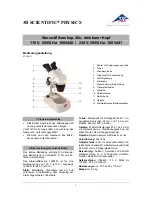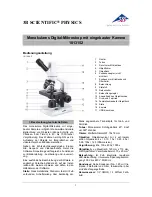
INTRODUCTION
Carl Zeiss
Microscopy in transmitted-light brightfield in a few steps
Axiovert 200
0-12
B 40-080 e 03/01
Microscopy in transmitted-light brightfield in a few steps
☞
Before starting to use the Axiovert 200, make sure to read the notes on instrument safety and
the chapters entitled "
Instrument Description
" (Chapter 1) and "
Start-up
" (Chapter 2).
•
Make the microscope ready for operation as described in chapter 2 and switch it on via the On/Off
switch (0-2/
1
).
•
Select the objective with the lowest magnification (e.g. 10x) on the nosepiece (0-2/
2
). Set factor 1x on
the setting wheel (0-2/
4
) of the Optovar turret.
•
Open the luminous-field diaphragm or the aperture diaphragm completely by pulling lever (0-2/
16
) to
the front until stop or by turning the setting wheel (0-2/
20
) to the front until stop.
•
Turn the setting ring (0-2/
19
) to move the condenser turret in position
H
for brightfield (or
DIC
).
•
Move reflector turret (0-2/
5
, if available) into the position without filter combination via the setting
ring.
•
If required, remove analyzer slider (0-2/
3
) or switch to free light path.
•
Turn setting wheel for Sideport right / left / vis (0-2/
22
) to position 100 % vis (visual
).
•
Turn setting knob for Frontport / Baseport / vis (0-2/
23
) to position 100 % vis (
VIS
).
•
Set beam splitting ratio to 100 % vis (0-2/
10
) on the tube. Switch off the Bertrand lens (if available).
Move combined rotary / slider knob (0-2/
9
) to position 100 % vis (
).
•
Place a high-contrast specimen on the microscope stage (0-2/
21
). Adjust the binocular component.
•
Use the coarse / fine focusing drive (0-2/
6
) to focus on the selected detail of the specimen. Should no
light be visible in the eyepieces, switch on the halogen illuminator via the HAL on / off switch (0-2/
7
).
•
Use the toggle switch (0-2/
8
) to set the light
intensity to comfortable brightness.
•
Close luminous-field diaphragm (0-2/
16
) until it
is visible in the field of view, even if not in focus
(0-1/
A
).
•
Focus on the edge of the luminous-field
diaphragm (0-1/
B
) by moving the condenser
(0-2/
17
) vertically.
•
Center (0-1/
C
) luminous-field diaphragm via the centering screws (0-2/
15
and
18
) and open it until
the edge of the diaphragm just disappears from the field of view (0-1/
D
).
•
Remove one eyepiece from the eyepiece tube (or swing in Bertrand lens) and set aperture diaphragm
(0-2/
20
) to approx. 2/3 of the diameter of the objective exit pupil (0-1/
E
). Optimum contrast setting is
dependent on the respective specimen.
•
Insert the eyepiece again (or swing out Bertrand lens) and refocus, if required, via the fine drive.
•
After the microscope has been set to transmitted-light brightfield in this way, changing to this special
contrasting technique is now possible (see chapter 3 of this manual).
Fig. 0-1
Diaphragm settings in transmitted-
light brightfield according to
KÖHLER
Summary of Contents for Axiovert 200
Page 1: ...Operating Manual Axiovert 200 Axiovert 200 M Inverted Microscopes...
Page 30: ...INSTRUMENT DESCRIPTION Carl Zeiss Technical Data Axiovert 200 1 16 B 40 080 e 03 01...
Page 34: ...START UP Carl Zeiss List of illustrations Axiovert 200 2 4 B 40 080 e 03 01...
Page 114: ...ANNEX Carl Zeiss Overview Axiovert 200 A 2 B 40 080 e 03 01...
Page 120: ...ANNEX Carl Zeiss List of key words Axiovert 200 A 8 B 40 080 e 03 01...













































